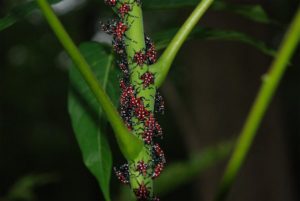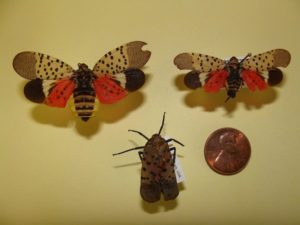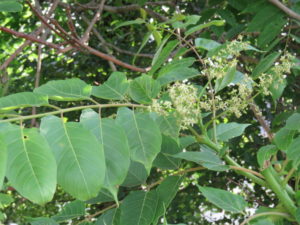Volume 23 Issue 2, Summer 2018
by Kerry Bzdyk

Immature Spotted Lanternfly
Photo by Virginia Cooperative Extension
Usually when I encounter an insect I have never observed before, the naturalist in me is thrilled and excited to learn more about it. But there is one insect I am just hoping none of us see here in Loudoun County. By now you may have seen reports of a new invasive insect species, the Spotted Lanternfly. The sense of alarm has increased in our region with the positive detection of this insect in Winchester last January. There are many reasons to educate yourself about this particular threat.
The Spotted Lanternfly (Lycorma delicatula) is a plant hopper that is native to Asia, where it primarily feeds on Tree of Heaven (Ailanthus altissima). Adults measure about an inch long and a half-inch wide with their wings folded. The forewings are mainly gray with black spots near the base and a darker region at the tip with lighter veins. The hind wings are a bright scarlet at the base, with an area of black with a white band. The abdomen is yellow, with black bands down the center. After hatching, nymphs develop through four wingless stages (instars), during which they are black with white spots and grow to about a half-inch long. The fourth instar develops red patches on the body. Winged adults appear in July.

Adult Lanternfly
Photo by Virginia Cooperative Extension
First detected in Berks County, Pennsylvania, in 2014, the Spotted Lanternfly has shown a remarkable ability to thrive and spread. It feeds on a large variety of plants, including grapes, apples, stone fruits, and many other agricultural and commercially valuable crops. In the fall, adults will aggregate (or gather in large groups), mainly on Tree of Heaven, and can be seen at dusk traveling up and down the trunks of trees in large numbers. Females will lay eggs on almost any hard surface, including those that move, like trucks, cars, shipping containers and trains, which is how they have spread not only to Virginia, but also to New York and Delaware. The egg masses are shiny, light gray, flat and up to 1.5 inches long and three-fourths of an inch wide. The egg mass fades to a dried mud looking mass over the winter.
In addition to being a threat to commercial crops, the Spotted Lanternfly is also a notable pest to homeowners. Lanternflies feed on ornamental and native vegetation and secrete honeydew, which is a sticky sweet liquid that attracts the growth of mold and the interest of ants and other unwanted insects.

Tree of Heaven
Photo by Steve Allen
Management of this invader targets the different life stages of the lanternfly and includes scraping of egg masses, targeted insecticides, tree banding and host tree removal. One adult management technique that has had some success is the removal of Ailanthus trees in an area with the exception of a few “trap” trees that are then treated with a systemic insecticide.
So what can you do? Be observant! Spread the word! If you have any Tree of Heaven on your property, have it removed. If you think you have found a Spotted Lanternfly, you can capture it and take the specimen to our county’s cooperative extension office in Leesburg. You can also take a photo and upload it to this website: https://ask.extension.org/groups/1981/ask.
With education, outreach, observation and determination we can all help to control the spread of this detrimental invasive species.
Resources:
For information about the spotted Lanternfly, see
https://www.ncipmc.org/action/alerts/lanternfly.pdf
https://ext.vt.edu/agriculture/commercial-horticulture/spotted-lanternfly.html
https://www.nytimes.com/2018/05/21/science/lanternflies-pennsylvania-crops.html
For information on how to identify and remove Ailanthus trees, see:
https://www.invasive.org/eastern/midatlantic/aial.html
https://ext.vt.edu/agriculture/commercial-horticulture/spotted-lanternfly.html

